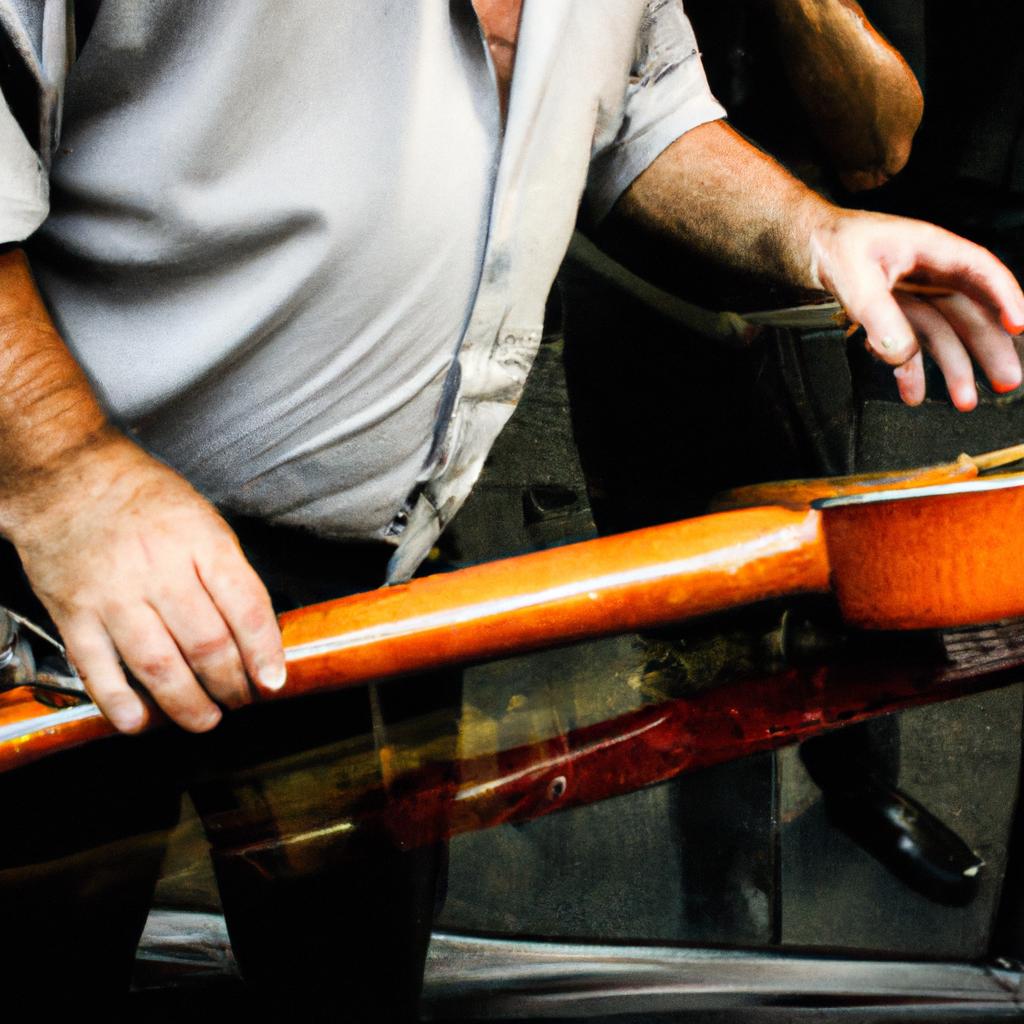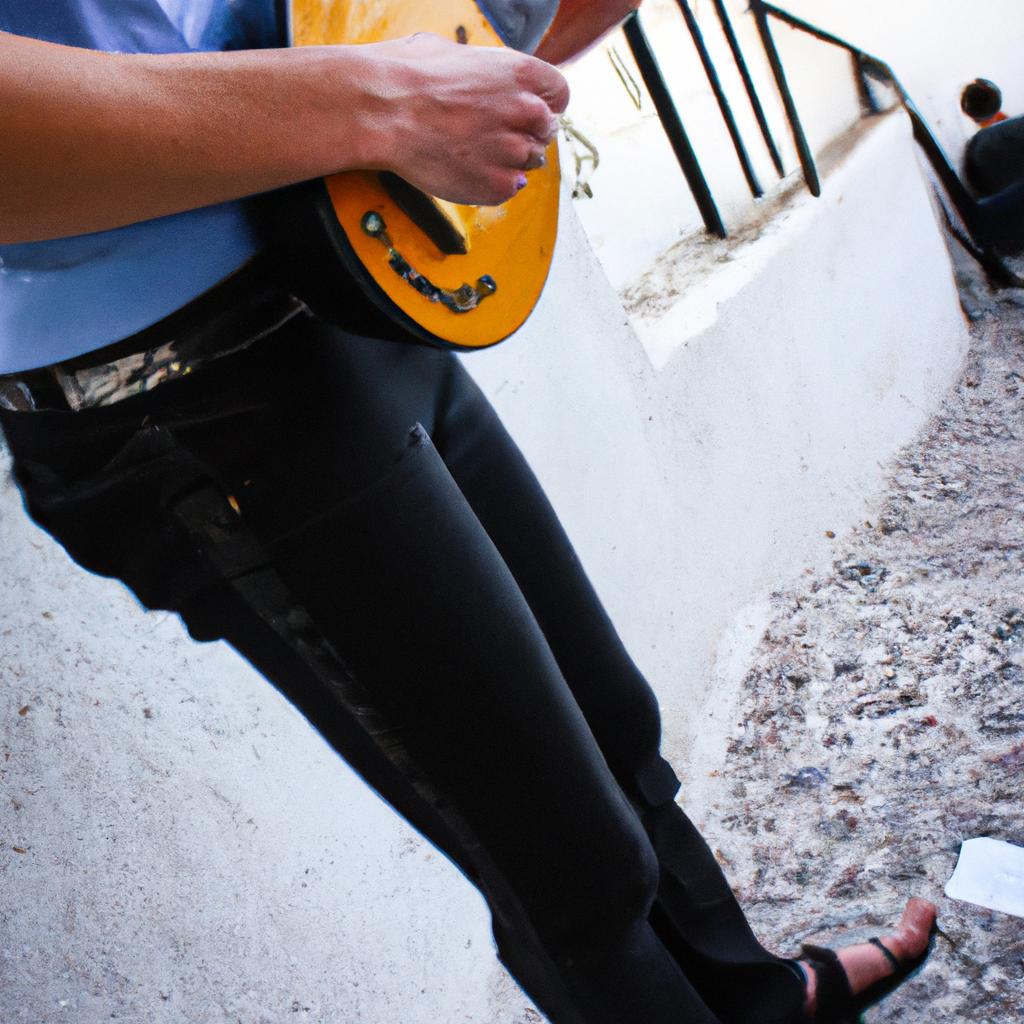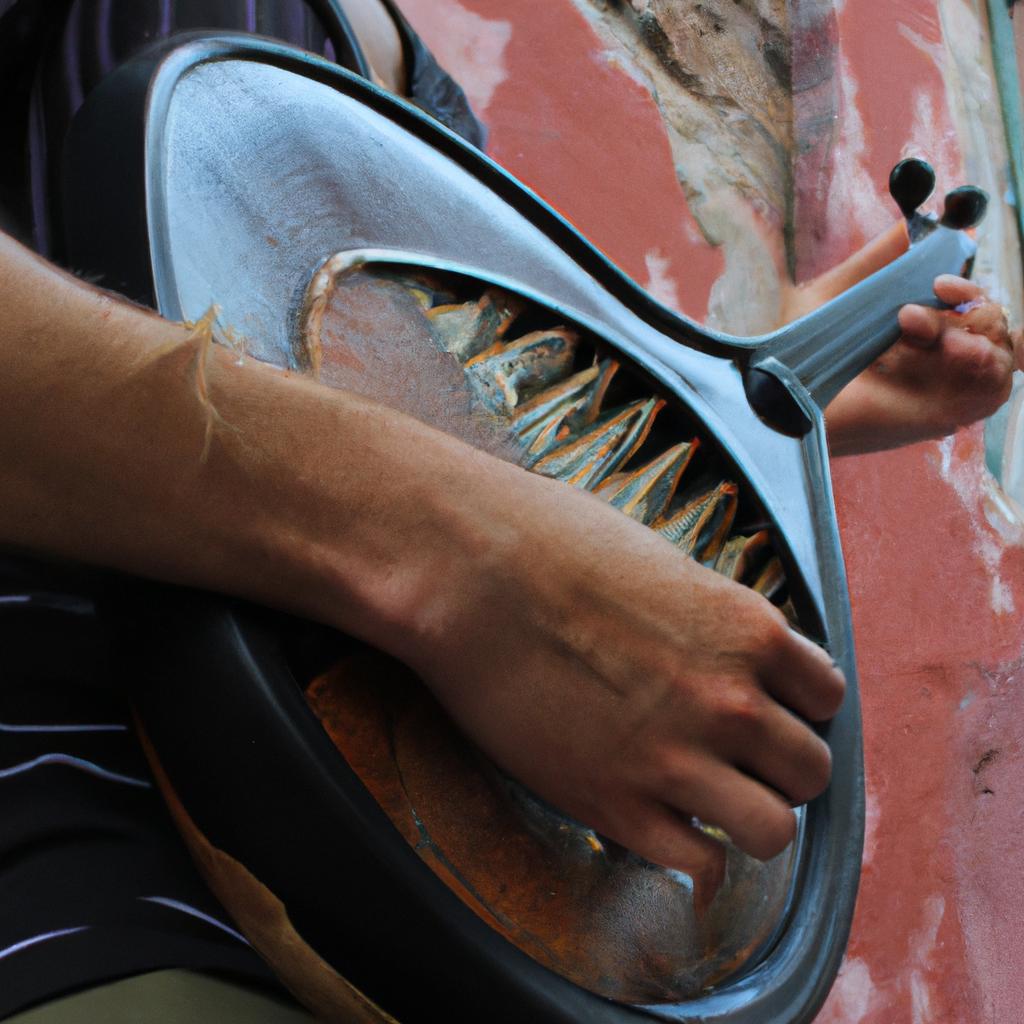The rich and captivating melodies of traditional tango music have long fascinated musicians, scholars, and enthusiasts alike. Exploring the instruments that contribute to this unique genre provides valuable insights into its historical development and cultural significance. By examining a case study of the bandoneón, an instrument synonymous with tango, we can delve deeper into the intricate relationship between musical instruments and the evolution of this beloved art form.
Traditional tango music emerged in the late 19th century as a fusion of European immigrant cultures in Buenos Aires, Argentina. The bandoneón, an accordion-like instrument originating from Germany, played a pivotal role in shaping the distinct sound of tango. Its expressive capabilities allowed musicians to convey a range of emotions through melancholic melodies and vibrant rhythms. As tango gained popularity throughout the early 20th century, the bandoneón became inseparable from its identity; it symbolizes both the struggles and triumphs experienced by immigrants in their new homeland.
This article aims to provide a comprehensive historical overview of various instruments used in traditional tango music beyond just the bandoneón. By understanding how these instruments evolved over time and influenced one another, readers will gain a deeper appreciation for the complexity and richness inherent in this passionate genre. Through exploring different types of instruments such as the guitar, violin, piano, and double bass, we can uncover the unique roles they play in tango music and how they contribute to its overall sound.
The guitar, for example, is a fundamental instrument in tango music. Its rhythmic strumming patterns provide the foundation for the danceable beat that characterizes this genre. The guitar’s versatility allows it to accompany both melodic lines played by other instruments and the singer’s voice in tango songs.
The violin adds a touch of elegance and expressiveness to tango music. With its ability to produce soaring melodies and emotive vibratos, the violin captures the passion and longing often associated with this art form. Tango orchestras typically feature one or more violins playing intricate solos and harmonies that enhance the overall texture of the music.
The piano serves as both a harmonic accompaniment and a solo instrument in tango. Its percussive nature contributes to the rhythmic drive of tango rhythms while also providing lush chords and melodic lines. Pianists in tango ensembles often showcase their technical prowess through virtuosic improvisations that add excitement and flair to performances.
Lastly, the double bass plays a crucial role in providing a solid foundation for tango music’s rhythmic structure. Its deep tones and steady pulse anchor the ensemble, allowing other instruments to weave melodies around it. The double bass provides a sense of stability amidst the passionate intensity of tango compositions.
These are just a few examples of instruments used in traditional tango music, each contributing its own unique timbre and musical characteristics. Understanding how these instruments interact with one another helps us appreciate the intricacies of tango arrangements and how they shape our emotional connection to this captivating genre.
In conclusion, exploring the instruments used in traditional tango music beyond just the bandoneón reveals an interconnected web of sounds that have shaped this vibrant art form over time. From the rhythmic drive of the guitar to the expressive melodies of the violin, each instrument contributes to tango’s rich tapestry of emotions and cultural significance. By delving into their historical development and roles within tango ensembles, we can gain a deeper appreciation for this beloved genre and its enduring appeal.
Unveiling the Origins of Tango Music Instruments
Unveiling the Origins of Tango Music Instruments
Imagine a smoky, dimly lit bar in Buenos Aires during the early 20th century. The sound of passionate music fills the air as couples move gracefully across the dance floor, their bodies intertwined in perfect harmony. At the heart of this captivating ambiance lies an array of traditional tango instruments that have shaped the unique and soulful sound of this beloved genre.
To understand the origins of tango music instruments, we must delve into the rich cultural heritage of Argentina. Born from a fusion of African rhythms, European melodies, and indigenous influences, tango emerged as an expression of love, sorrow, and longing within working-class neighborhoods known as “arrabales.” As this musical style gained popularity among both locals and immigrants alike, musicians began to experiment with various instruments to create its distinct emotive soundscape.
One significant instrument central to tango is the bandoneón. This German-imported accordion-like instrument became synonymous with Argentine tango after it was introduced by immigrants in the late 19th century. Its melancholic tone perfectly captured the raw emotions embedded within each note and quickly established itself as an essential component in any tango ensemble.
In addition to the bandoneón, other traditional instruments commonly found in early tango compositions include:
- The violin: With its soaring melodies and expressive capabilities, the violin adds a touch of elegance and virtuosity to tango performances.
- The guitar: Often used for rhythmic accompaniment or solos, the guitar provides a foundation upon which other instruments can build intricate layers of sound.
- The piano: Frequently employed in larger orchestras or for solo performances, pianos bring depth and complexity to tango arrangements through their ability to produce harmonies and melodic flourishes.
These four key elements form a powerful synergy that evokes a range of emotions within listeners—joyful exuberance or heartfelt nostalgia, among others. The combination of the bandoneón’s haunting melodies, the violin’s soaring lines, the guitar’s rhythmic drive, and the piano’s lush harmonies creates a captivating sonic landscape that resonates deeply with audiences.
As we explore further into the history of tango music instruments, we will witness their evolution over time and how they have adapted to new musical contexts while still preserving their essential qualities. Join us on this journey as we uncover the transformative power of these instruments in shaping traditional tango music.
[Table]
| Instrument | Function |
|---|---|
| Bandoneón | Captures melancholic emotions |
| Violin | Adds elegance and virtuosity |
| Guitar | Provides rhythmic foundation or solos |
| Piano | Brings depth and complexity through harmonies |
Next section: The Evolution of Traditional Tango Instruments
The Evolution of Traditional Tango Instruments
In order to fully comprehend the historical development of traditional tango music instruments, it is crucial to delve into their origins. By examining the birthplace and early influences of these instruments, we can better grasp how they became integral components of tango’s musical landscape.
To illustrate this point, let us consider the bandoneón — a key instrument in tango music. The bandoneón originated in Germany during the 19th century as a type of portable reed organ. Initially designed for religious purposes, it eventually found its way to Argentina through German immigrants. Here, it underwent various modifications to suit the unique stylistic requirements of tango music. This case study exemplifies how cultural exchange played a pivotal role in shaping traditional tango instruments.
The evolution of traditional tango instruments can be explored through several notable aspects:
-
Cultural Fusion: Tango music emerged from a melting pot of cultures in Buenos Aires, blending African rhythms with European melodies and harmonies. Similarly, traditional tango instruments bear significant influence from diverse sources such as Italian accordions and Spanish guitars.
-
Technological Advancements: As technology advanced over time, so did the construction and design of tango instruments. For instance, advancements in metalworking techniques allowed for improvements in the manufacturing process of brass wind instruments like trumpets and trombones.
-
Socioeconomic Factors: Tango’s popularity surged during times of social change and economic growth in Argentina. This led to an increased demand for live performances, prompting musicians to experiment with different instrument combinations to create richer sounds that resonated with audiences emotionally.
-
Artistic Innovation: Musicians continuously pushed boundaries by exploring new playing techniques and experimenting with unconventional instrument pairings within tango ensembles. These creative endeavors expanded the sonic possibilities within traditional tango music.
By understanding these facets within the historical context of traditional tango music instruments, we gain valuable insights into their development and significance. This knowledge serves as a foundation for exploring the subsequent section on iconic instruments in tango’s golden era, where we will delve deeper into specific instruments that played pivotal roles during this influential period.
Now let us transition to the subsequent section about “Iconic Instruments in Tango’s Golden Era,” which delves further into the instruments that defined tango music during its most celebrated epoch.
Iconic Instruments in Tango’s Golden Era
In the early years of tango, as it emerged in the late 19th century within the working-class neighborhoods of Buenos Aires, a distinct set of instruments began to take center stage. These instruments not only defined the sound and character of traditional tango music but also played an essential role in its evolution over time.
One fascinating case study that exemplifies this evolution is the bandoneón. Originally introduced to Argentina by German immigrants, this button accordion quickly found its way into tango ensembles. Its melancholic and expressive tones became synonymous with the genre, captivating audiences and adding a unique dimension to tango compositions.
To fully appreciate the significance of these instruments, let us explore their characteristics:
- Bandoneón: With its bellows-driven mechanism producing rich harmonic layers, it lends an air of nostalgia and longing to tango melodies.
- Violin: Known for its ability to convey both fiery passion and delicate emotion, the violin brings depth and complexity to tango orchestras.
- Piano: Serving as a rhythmic anchor while also providing intricate harmonies, the piano adds texture and color to tango arrangements.
- Double Bass: Resonating with deep resonance and pulsing rhythms, this instrument grounds tango ensembles with its powerful presence.
These four pillars form the foundation upon which traditional tango music was built. To further illustrate their importance, consider Table 1 below:
Table 1: Key Characteristics of Traditional Tango Instruments
| Instrument | Characteristic |
|---|---|
| Bandoneón | Expressive |
| Violin | Passionate |
| Piano | Textured |
| Double Bass | Powerful |
As we delve deeper into the golden era of tango music in our next section, it becomes evident that these iconic instruments shaped not only individual compositions but also influenced subsequent generations of musicians. Their distinctive sounds continue to resonate with audiences worldwide, evoking a range of emotions from wistfulness to exhilaration.
Transitioning seamlessly into our subsequent section on “The Influence of European Instruments on Tango Music,” we explore how the encounter between these traditional tango instruments and European counterparts paved the way for further musical exploration and innovation.
The Influence of European Instruments on Tango Music
From the iconic instruments that defined Tango’s Golden Era, we now turn our attention to the influence of European instruments on Tango music. While traditional tango instrumentation primarily consisted of bandoneón, guitar, piano, and violin, the introduction of European instruments brought new sonorities and expanded possibilities for musicians.
One fascinating example is the adoption of the clarinet in Tango orchestras during the 1930s. This woodwind instrument added a rich and expressive tone to the ensembles, complementing the passionate emotions conveyed by the other instruments. Its soaring melodies could evoke both melancholy and joy, capturing the essence of Tango’s emotional depth.
The incorporation of European instruments into Tango music not only broadened its sonic palette but also reflected cultural exchange between Argentina and Europe. Here are some key points regarding this influence:
- Diverse timbres: The addition of European brass instruments like trumpet and trombone introduced vibrant and brassy tones to Tango arrangements.
- Expanded harmonic range: Instruments such as the accordion enabled complex chord progressions and enriched harmonies within Tango compositions.
- Innovation in rhythm: Percussion instruments like drums provided rhythmic variations that intensified dance rhythms and added an energetic drive to Tango performances.
- Cross-cultural fusion: The integration of these European instruments with traditional Argentine ones created a unique blend of musical traditions, showcasing a synthesis between different cultures.
To illustrate this interplay further, let us examine how various instrumental combinations affected tango orchestration during this period through a table:
| Instrumentation Combination | Characteristics |
|---|---|
| Bandoneón + Clarinet | Melancholic & expressive melodies |
| Violin + Trumpet | Dynamic contrast & virtuosic passages |
| Guitar + Accordion | Complex harmonies & intricate rhythms |
| Piano + Drums | Energetic pulse & syncopated patterns |
This table exemplifies how these instrument pairings contributed to the vibrant and diverse soundscape of Tango music, showcasing its evolution as a genre that embraced both tradition and innovation.
Traditional Tango Instruments in Modern Times continue to shape the tango scene today. The enduring legacy of these instruments can be witnessed in contemporary orchestras and ensembles dedicated to preserving the authenticity of traditional Tango. By delving into their historical significance, we gain a deeper understanding of how Tango has evolved over time while staying true to its roots.
Traditional Tango Instruments in Modern Times
Section H2: Traditional Tango Instruments in Modern Times
Having examined the profound influence of European instruments on tango music, we now turn our attention to the traditional instruments that have become synonymous with this genre. These instruments not only define the unique sound of tango but also play a crucial role in its cultural significance and emotional expression.
In exploring the role of traditional tango instruments, let us consider the bandoneón as a prime example. This distinctively Argentine instrument resembles an accordion and is often hailed as the soul of tango music. Its expressive qualities enable musicians to convey intense emotions through their playing, evoking nostalgia, longing, or even joyous celebration. The bandoneón’s rich timbre and ability to produce sustained notes make it indispensable in capturing the essence of tango’s melancholic melodies.
To fully appreciate the diversity within traditional tango instrumentation, let us delve into some key elements:
- The piano serves as both a rhythmic backbone and melodic accompaniment for tango ensembles. With its percussive quality and versatility, it sets the foundation for other instruments while adding depth and complexity to compositions.
- The violin brings elegance and passion to tango music with its soaring melodies and virtuosic performances. It can effortlessly shift between sorrowful lamentations and fiery expressions of desire, creating a captivating dialogue with other instrumental voices.
- The double bass provides a steady pulse that drives the rhythm forward, anchoring the ensemble’s harmonic structure. Its deep resonance adds warmth and depth to tango arrangements, grounding them in a strong foundation.
- Percussion instruments like drums or cajon offer dynamic accents and syncopated rhythms that intensify the danceable nature of tango music. They infuse energy into performances, compelling listeners to move along with each beat.
To further illustrate how these instruments come together harmoniously within a typical tango ensemble, we present the following table:
| Instrument | Role in Tango Ensemble | Notable Performers |
|---|---|---|
| Bandoneón | Melodic and Emotional Expression | Astor Piazzolla, Anibal Troilo |
| Piano | Harmonic Support and Rhythmic Foundation | Osvaldo Pugliese, Horacio Salgán |
| Violin | Ornamental Flourishes and Expressive Solos | Elvino Vardaro, Enrique Mario Francini |
| Double Bass | Provide Steady Pulse and Deep Resonance | Juan Carlos Cobián, Roberto Tormo |
By exploring the unique roles of these traditional tango instruments, we gain a deeper understanding of how they contribute to the overall character of this genre. In our subsequent section on “Exploring the Role of Instruments in Tango Orchestras,” we will delve into their collective interplay within larger ensembles, shedding light on the dynamic nature that defines tango music’s orchestral arrangements.
Exploring the Role of Instruments in Tango Orchestras
Transitioning from traditional tango instruments in modern times, we now delve deeper into exploring the role of these instruments within tango orchestras. To illustrate this, let us consider a hypothetical scenario where a renowned tango orchestra decides to experiment with contemporary elements while preserving the essence of traditional tango music.
In this hypothetical case study, Tango Ensemble X aims to infuse their performance with electronic sounds and incorporate unconventional instruments such as synthesizers alongside the classic bandoneón and violin. By doing so, they hope to capture the attention of younger audiences who are accustomed to more modern genres. This innovative approach raises intriguing questions about how instrumental choices shape the overall sound and emotional impact of tango music.
To better understand the intricacies involved, let us explore four key aspects that contribute to the emotional intensity of tango performances:
- Rhythm: The rhythmic patterns inherent in traditional tangos create a pulsating energy that drives dancers’ movements and evokes passion among listeners.
- Melody: The melodies played by each instrument convey various emotions – longing, desire, or melancholy – which resonate deeply within both performers and spectators.
- Harmony: Harmonic progressions add depth and complexity to tango compositions, enhancing tension and resolution moments throughout musical phrases.
- Texture: The interplay between different instruments determines the richness and density of sound in a tango orchestra, allowing for nuanced expressions.
To illustrate how these elements interact within a typical tango ensemble, consider the following table showcasing an example arrangement:
| Instrument | Role | Emotional Impact |
|---|---|---|
| Bandoneón | Lead melodic instrument | Elicits nostalgia and yearning through its mournful tone |
| Violin | Counterpoint to bandoneón | Adds layers of emotion with soaring lines |
| Piano | Harmonic foundation | Provides lush chords and rhythmic support |
| Double Bass | Rhythmic backbone | Establishes the driving pulse of tango music |
In conclusion, while traditional tango instruments have remained central to orchestras over time, they have also evolved in response to changing musical landscapes. By incorporating contemporary elements into their performances, Tango Ensemble X demonstrates the fluidity of tango music’s development and its ability to resonate with diverse audiences. Understanding how instrumental choices shape emotions within a tango orchestra allows us to appreciate the nuanced artistry involved in creating this captivating genre.




